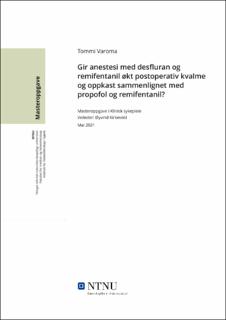| dc.contributor.advisor | Kirkevold, Øyvind | |
| dc.contributor.author | Varoma, Tommi | |
| dc.date.accessioned | 2021-09-24T19:51:39Z | |
| dc.date.available | 2021-09-24T19:51:39Z | |
| dc.date.issued | 2021 | |
| dc.identifier | no.ntnu:inspera:77255139:49672549 | |
| dc.identifier.uri | https://hdl.handle.net/11250/2782364 | |
| dc.description.abstract | Introduksjon
Postoperativ kvalme og oppkast (POKO) er blant de vanligste postoperative komplikasjonene. Tradisjonelt har anestesi med gass vært forbundet med høyere forekomst av POKO enn intravenøs anestesi med propofol (TIVA), men tidligere studier på desfluran har ikke vært entydige på denne forskjellen.
Hensikt
Hensikten med studien er å finne ut om det er mer POKO etter anestesi med desfluran og remifentanil sammenlignet med propofol og remifentanil og om det er andre forhold enn type anestesi som påvirker POKO.
Metode
Retrospektiv data ble samlet inn på 139 pasienter som hadde gjennomgått laparoskopisk kolecystektomi. Av alle inkluderte hadde 75 pasienter fått TIVA og 64 desfluran. Administrasjon av kvalmestillende medikament ble brukt som indikasjon for forekomst av POKO. Det ble brukt deskriptiv statistikk for å finne forskjeller mellom gruppene og det ble gjort en multivariat logistisk analyse for å korrigere for andre forhold som kan påvirke POKO.
Resultat
Gruppene var ikke statistisk signifikant forskjellige fra hverandre bortsett fra fordeling av ASA-klassifikasjon. Det var 28 % i desfluran gruppen som fikk kvalmestillende medikamenter postoperativt mot 12% i propofol gruppen. Multivariat logistisk regresjonsanalyse viste at desfluran, kvinner og bruk av opioider postoperativt gir en signifikant større odds for å bli kvalm med OR på henholdsvis 3,6, 5,3 og 1,3.
Konklusjon
Over dobbelt så stor andel pasienter som hadde fått anestesi med desfluran fikk kvalmestillende medikamenter postoperativt, sammenlignet med gruppen som fikk TIVA. Korrigert for andre variabler var kvinner signifikant oftere kvalme enn menn, forskjellen mellom anestesimetodene økte noe og opioider brukt postoperativt hadde en statistisk signifikant sammenheng med POKO. | |
| dc.description.abstract | Introduction
Post-operative nausea and vomiting (PONV) is among the most common postoperative complications. Volatile anesthesia has traditionally been associated with higher prevalence of PONV than propofol based intravenous anesthesia (TIVA), but earlier studies of desflurane have not been conclusive of this difference.
Aim
The aim of this study is to assess if anesthesia with desflurane and remifentanil causes more PONV than anesthesia with propofol and remifentanil and if there are other variables besides the type of anesthesia that affects PONV.
Method
Retrospective data of 139 patients who had surgery for laparoscopic cholecystectomy was obtained with 75 patients in the TIVA group and 64 in the desflurane group. Administration of antiemetic drugs was used as indication of PONV in the postoperative ward. Descriptive statistics was used to find differences between the groups and a multivariate logistic regression was performed to correct for other variables that may affect PONV.
Results
There was no significant difference between the groups besides ASA-classification. Antiemetics was administered postoperatively to 28% of the patients in the desflurane group and to 12% of the patients in the TIVA group. The multivariate logistic regression shows that desflurane, female sex and the use of postoperative opioids had a significant odds ratio for PONV with OR respectively 3,6, 5,3 and 1,3.
Conclusion
Over twice as large a percentage of patients were administered antiemetics in the desflurane group compared to the TIVA group. Corrected for other variables women experienced PONV more often than men, the difference between types of anesthesia increased slightly and the use of postoperative opioids had a statistically significant association with nausea. | |
| dc.language | nob | |
| dc.publisher | NTNU | |
| dc.title | Gir anestesi med desfluran og remifentanil økt postoperativ kvalme og oppkast sammenlignet med propofol og remifentanil? | |
| dc.type | Master thesis | |
